Great Garden Combo: Tropical Beauties for a Sun-Drenched Border
I recently had the opportunity to visit the Harry P. Leu Gardens in Orlando, Florida, and was entranced by the lush, vibrant plants at every turn — most of which I could enjoy only as houseplants in Seattle. I was especially interested to see what plant combinations the gardens showcased, having experienced the tropical downpours firsthand yet knowing that Florida also experiences extreme drought conditions.
I confess that my expectations were low. How could you possibly create a rich plant tapestry that would cope equally well with torrential rain and intense sun? The answer, as always, is to use the right plant in the right place. Rather than fighting nature, the designers selected only those plants that had a solid reputation of thriving in such conditions — not just surviving in them.
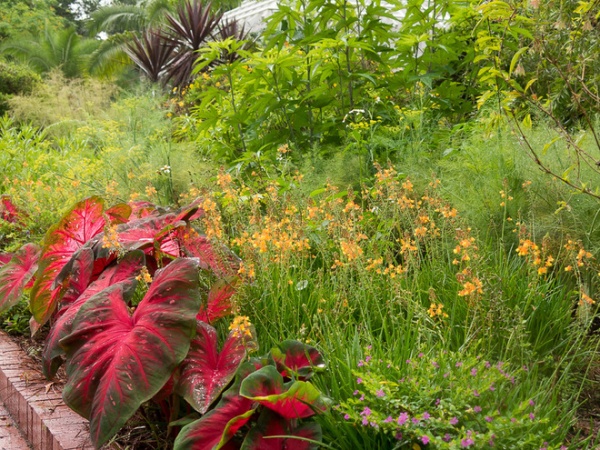
The result is a cross between bold tropical and informal cottage styles — a wild combination but one that truly works. The oversize heart-shaped leaves of caladium balance the fine feathery texture of fennel, while orange spires of snake flower shoot skyward from foliage that resembles a succulent form of chives.
Blending edibles and ornamentals has always been popular in England and is becoming more so in the United States, but the tropical caladium leaves make it clear that this is no ordinary English garden.
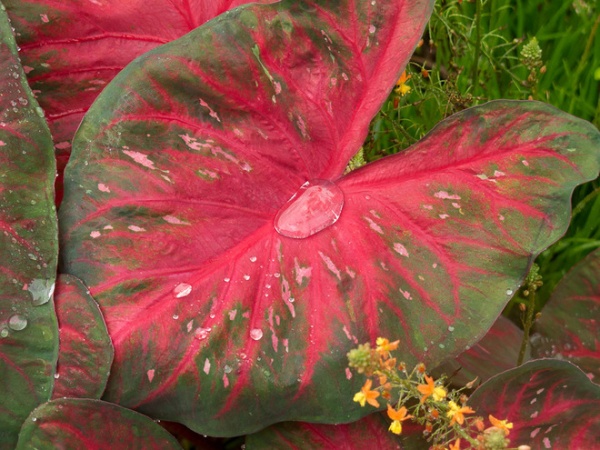
Here’s how to get the look.
1. Start with a ribbon of bold, colorful foliage.
Red Flash Caladium, Elephant Ear
(Caladium bicolor ‘Red Flash’)
While most caladiums prefer partial shade, the ones in the new Sun series will also take full sun (although they may require a little more water to withstand such conditions).
Red Flash is a popular sun-tolerant variety with vibrant red foliage, speckled with pink and having a wide margin of deep blue-green. Placed at the front of the border, it creates a bold and colorful frame for the looser foliage and flowers behind it.
Origin: South America
Where it will grow: Hardy to 30 degrees Fahrenheit (USDA zones 9b to 11; find your zone)
Water requirement: Average to low; avoid waterlogged soils
Light requirement: Full sun to partial shade
Mature size: 2 to 3 feet tall and 2 feet wide
When to plant: In spring after the last frost when soil temperatures are between 65 and 70 degrees.
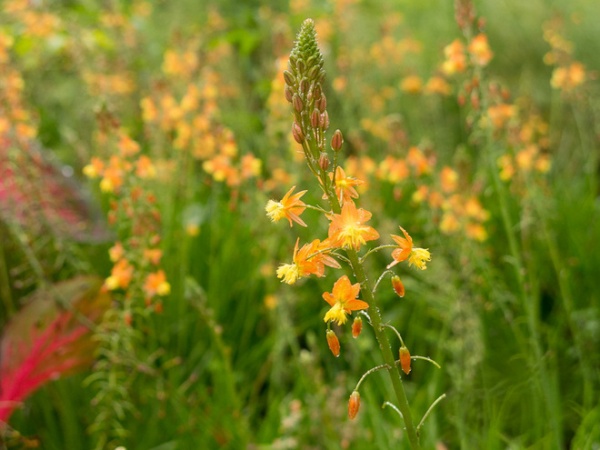
2. Fill in the middle ground with a long-blooming perennial.
Snake Flower, Burn Jelly Plant
(Bulbine frutescens ‘Hallmark’)
Something that caught my eye was the way all the plants were allowed to freely mingle, and snake flower did it with style — wands of color peeked out from between caladium leaves and jostled for position with the taller herbs.
The succulent foliage is evergreen and spreads by rhizomes to form a ground cover, from which rise stems of bold orange flowers that continue to appear for many months.
Origin: South Africa
Where it will grow: Hardy to 20 degrees Fahrenheit (USDA zones 8b to 11)
Water requirement: Low
Light requirement: Full sun or partial shade
Mature size: 1 foot to 2 feet tall and 4 to 5 feet wide
When to plant: In spring in well-drained soil
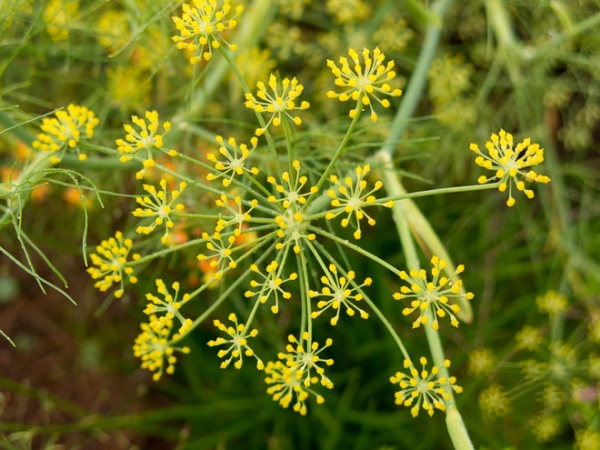
3. Add in taller plants with a soft, feathery texture.
Fennel
(Foeniculum vulgare)
Here is something that grows outside the Southeast. Fennel is an herb that is far more than just a herb. Certainly both the fragrant leaves and seeds are used in cooking, but I love to grow fennel just for the foliage. It looks very similar to dill; crushing a leaf the easiest way to tell the difference, since fennel smells like licorice.
Fennel adds an airiness to the combination — a perfect counterpoint to the caladium while adding height and a framework for the snake flower. The sprays of yellow flowers also add a new shape to the scene while echoing the citrus shades of the snake flower.
Origin: Southern Europe
Where it will grow: Hardy to minus 30 degrees Fahrenheit (USDA zones 4 to 9). In colder areas it can be grown as an annual.
Water requirement: Average to low
Light requirement: Full sun
Mature size: To 7 feet tall and 3 feet wide
When to plant: In spring after the danger of frost has passed.
Caution: Fennel self-seeds readily and may be invasive in some areas. Check with your local cooperative extension or county extension office before planting it.
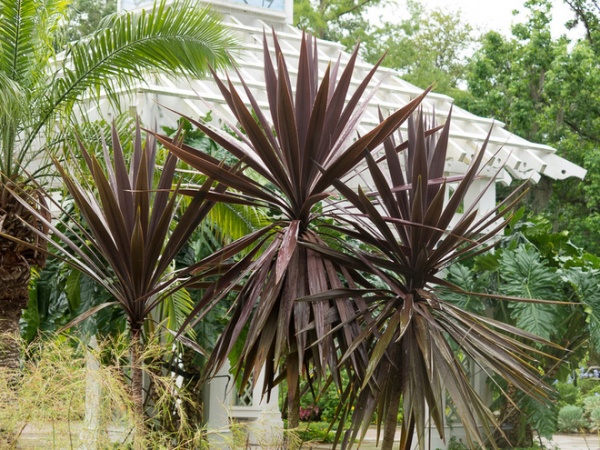
4. Extend the design by taking advantage of the “borrowed” landscape.
False Dracaena, Cordyline, Cabbage Tree
(Cordyline australis ‘Purpurea’)
Although not strictly part of this combination, this cordyline struck me as playing an important role as a backdrop. The bold leaves of both the caladium and cordyline bookend the finer textures, framing the more delicate plants. Similarly, the deep burgundy adds a final blast of color to the scene.
When we take advantage of a distant scene in this way, we refer to it as borrowed landscape, and our more immediate plants are enhanced by those in the backdrop.
Origin: New Zealand
Where it will grow: Hardy to 30 degrees Fahrenheit (USDA zones 8 to 11)
Water requirement: Average to low
Light requirement: Full sun to partial shade
Mature size: Varies depending upon the variety
When to plant: When temperatures are above freezing; in cooler climates plant it in spring
More: Create a vacation paradise with tropical garden style












